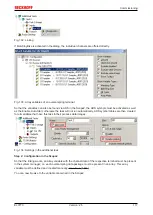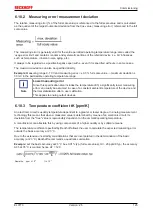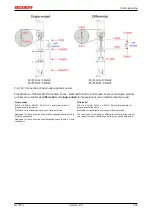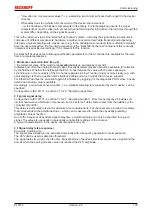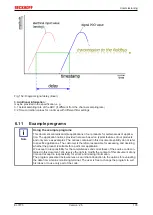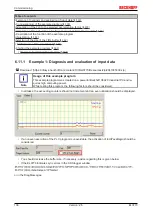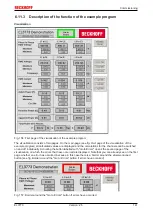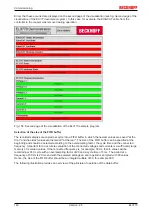
Commissioning
EL3773
128
Version: 2.5
Typification of the 2/3/4-wire connection of current sensors
Current transducers/sensors/field devices (referred to in the following simply as ‘sensor’) with the industrial
0/4-20 mA interface typically have internal transformation electronics for the physical measured variable
(temperature, current, etc.) at the current control output. These internal electronics must be supplied with
energy (voltage, current). The type of cable for this supply thus separates the sensors into
self-supplied
or
externally supplied
sensors:
Self-supplied sensors
• The sensor draws the energy for its own operation via the sensor/signal cable + and -.
So that enough energy is always available for the sensor’s own operation and open-circuit detection is
possible, a lower limit of 4 mA has been specified for the 4-20 mA interface; i.e. the sensor allows a
minimum current of 4 mA and a maximum current of 20 mA to pass.
• 2-wire connection see Fig.
2-wire connection
, cf. IEC60381-1
• Such current transducers generally represent a current sink and thus like to sit b and – as a
‘variable load’. Refer also to the sensor manufacturer’s information.
Fig. 145: 2-wire connection
Therefore, they are to be connected according to the Beckhoff terminology as follows:
preferably to
‘single-ended’ inputs
if the +Supply connections of the terminal/ box are also to be used -
connect to +Supply and Signal
they can, however, also be connected to
‘differential’ inputs
, if the termination to GND is then
manufactured on the application side – to be connected with the right polarity to +Signal and –Signal
It is important to refer to the information page
Configuration of 0/4..20 mA differential inputs
(see
documentation for the EL30xx terminals, for example)!
Externally supplied sensors
• 3- and 4-wire connection see Fig.
Connection of externally supplied sensors
, cf. IEC60381-1
• the sensor draws the energy/operating voltage for its own operation from 2 supply cables of its own.
One or two further sensor cables are used for the signal transmission of the current loop:
◦ 1 sensor cable: according to the Beckhoff terminology such sensors are to be connected to
‘single-ended’ inputs
in 3 cables with +/-/Signal lines and if necessary FE/shield
◦ 2 sensor cables: for sensors with 4-wire connection based on +supply/-signal/-signal,
check wsignal can be connected to +supply or –signal to –supply.
- Yes: then you can connect accordingly to a Beckhoff
‘single-ended’ input
.
- No: the Beckhoff
‘differential’ input
for +Signal and –Signal is to be selected; +Supply and –
Supply are to be connected via additional cables.
It is important to refer to the information page
Configuration of 0/4..20 mA differential inputs
(see documentation for the EL30xx terminals, for example)!
Note: expert organizations such as NAMUR demand a usable measuring range <4 mA/>20 mA for error
detection and adjustment, see also NAMUR NE043.
The Beckhoff device documentation must be consulted in order to see whether the respective device
supports such an extended signal range.
Usually there is an internal diode existing within unipolar terminals/ boxes (and related product groups), in
this case the polarity/direction of current have to be observed.
Summary of Contents for EL3773
Page 1: ...Documentation EL3773 Power Monitoring Oversampling Terminal 2 5 2018 03 13 Version Date...
Page 2: ......
Page 6: ...Table of contents EL3773 6 Version 2 5...
Page 39: ...Mounting and wiring EL3773 39 Version 2 5 Fig 29 Other installation positions...
Page 41: ...Mounting and wiring EL3773 41 Version 2 5 Fig 31 Block diagram...
Page 47: ...Commissioning EL3773 47 Version 2 5 Fig 38 Incorrect driver settings for the Ethernet port...
Page 147: ...Commissioning EL3773 147 Version 2 5 Fig 168 Confirming program start...




